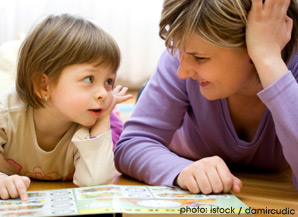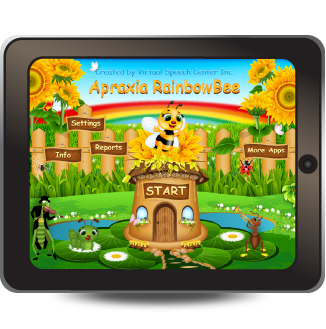 In today’s guest post, Natalie Romanchukevich advises readers on how to create opportunities to expand children’s spontaneous communication skills.
In today’s guest post, Natalie Romanchukevich advises readers on how to create opportunities to expand children’s spontaneous communication skills.
Helping young children build speech- language skills is an exciting job that both caregivers and educators try to do every second of the day. We spend so much time giving our children directions to follow, asking them a ton of questions, and modeling words and phrases to shape them into eloquent communicators.
What I find we do NOT do enough, sometimes, is hold back on our never ending “models” of what or how to say things, questions, and directions, instead of allowing our children initiate and engage with us. Greenspan refers to these initiations as opening circles of communication (Weirder & Greenspan “Engaging Autism”, 2006).
Speech- language development can be thought of as having three interacting and equally important domains- Form ,Content, and Use (Lahey, 1988).
Form refers to the grammatical correctness of our words and sentences (eat vs. eat+ ing).
Content is what the we are essentially communicating- the meaning of our words and sentences.
Use (also known as pragmatics) refers to the function of our words or for what purpose we are using them.

The communicative functions that slowly emerge and characterize communication over the course of language acquisition in vary in typically developing young children. Children communicate to greet others, comment on objects/actions, request desired objects, request assistance, protest, deny (a statement), ask questions, regulate others (e.g. “blow!”, “open!”), entertain, and narrate events.
In order for children to be able to express these functions, aside from the intent to communicate, there must also be opportunities to express ideas, wants, needs. For example, why would Timmy request for an object (nonverbally or verbally) if the caregiver hands everything to the child at the slightest sign of a tantrum. Why ask a “where?” question if every toy or beloved object is comfortably in sight? Why ask for help if the caregiver readily assists the child with all activities. The educators describe it as assuming the child’s needs.
Of course we do it out of love and care for the child, and, let’s be honest, sometimes, to save time. However, it is important with both typical and delayed children to be mindful of what (form, content, use) we model, when (timing is crucial in teaching) we model it, how (facial expression, tone of voice, etc) we model it, and why (is it developmentally important to teach it now?) we model it at this very moment.
Just as it is important for kids to comprehend concepts, follow directions, and understand the different wh- questions, it is also paramount that your child is able to initiate communication. After all, communication is the ability to express ideas, thoughts, and wants, not just understand those expressed by others. Answering questions and following commands is not initiating. Language that is elicited by us- is not spontaneous.
To use language spontaneously, effortlessly and creatively, children need opportunities to practice the skill, to experience taking the lead. In order for our children to get there, we must first offer models of how to initiate communication and do so appropriately. We can then create opportunities for the child to speak up.

The most basic strategies you can use to encourage spontaneous initiations (whether nonverbal or verbal) may seem seem initially as counterintuitive. I mean what is the point to introducing attractive new toys or displaying a yummy snack and then putting it away? Yet it is exactly that action which may very much encourage your child to run after you with gestures or words. Even then, you may still choose to play “dumb” and be “unsure” as to what it is your child wants. Does s/he want that bag with new toy or snack “opened?” and “out?”
If the child is nonverbal, his use of gestures to regulate your actions to get the desired item out and open may be the child’s initial step toward sound imitation. If you are working on getting the child to request help (not just objects), here is your opportunity to model “help” if the child can’t open the item independently. On a side note, I often hear educators model “help me please!” when the child is clearly at a single word level. This is not a developmental way of teaching. Yes, it is nice to hear a full sentence but your child may not be ready for it.
While playing with your child and actively commenting on your joint play, you may find it productive to suddenly become quiet and cease all attempts to ask questions. This often works beautifully in my therapy sessions; usually, after I have engaged the child into some sort of cooperative and enjoyable play! But it takes a conscious effort and self-control on the part of the adult, since we are so used to engaging in this adult- directed (telling the child what to do as opposed to letting him/her lead and you follow) approach to teaching.

However, once you are able to contain your speech and actions (I promise you it is possible), you may be surprised to hear some immediate or delayed imitations of words/ phrases as well as spontaneous meaningful language. The language produced, to me, is an indication that the child wants more of the experience- more language enriched play. Use this opportunity to expand on what s/he is already saying.
Here, timing is really important as you want to imitate back everything your child is doing. This is another way to communicate with your child. Build on your child’s language to further describe the objects or people in play without using long sentences. So, allowing nothing to happen for a few minutes at a time may just be the push to help your child come out with some form of communication.
In addition, stopping a novel activity or toy exploration at the very height of your child’s excitement also works well with many children. You don’t have to be confrontational about it, “if you don’t imitate my word/ phrase I just won’t give it back to you”. make sure to create these “obstructions”, as Greenspan refers to them, in a friendly, playful and positive manner. Obstructions or fabricated “problems” are also a big part of social-cognitive and constructivist theories of language learning.
The idea behind these “obstructions” is that the children are forced to problem solve and use resources (language being one of them!) so they can get what they want. Allowing your child to problem solve is critical to overall cognitive development that affects and shapes speech and language. Presenting your child with developmentally appropriate activities that involve thinking and figuring out of how to get X is an invaluable strategy that I always use with all of my children.
In sum, stop access to items that are already loved, tape up containers, close boxes and jars with favorite snack and toys, give your child all but ONE important item that is needed to complete an activity (glue, scissors), give your child the “wrong” item, or offer the “wrong” solution to the problem. All of these “problems” will push the kid to think and figure out what to do next. This, in turn, facilitates spontaneous language use.
Letting go of control and just allowing for things to spill, break, or simply not follow the predictable comfortable routine, too, elicits a ton of speech- language and fun communication. These are the most teachable moments as our children experience all the new words and concepts first hand. Perhaps, this is why many children learn “dirty” or “wet” attributes before they learn their colors. These concepts are more easily learned because they are experiential and bring about relevant words to describe these personally relevant and emotional experiences. Cleaning up and taking turns arranging things back in place is super educational too as our children need to learn responsibility and helping others.

Moreover, exposing children to objects that are completely novel and foreign (but safe!) may help elicit an attempt to ask a question “what this?” because the child wants to know. The motivation is there. Now s/he needs language to get the answer from you. Some children may use a word with a rising intonation, which too is a question form, just not grammatically mature one. For example, “Hat?” is as much of a question as “Is that a hat?!”. If all your child is capable of verbalizing is “wow”, then you can go ahead and model “what IS that?” question a few times. Of course, you want to pair it up with an exaggerated expression of surprise and excitement in your voice.
To sum up, do not be afraid to experiment, get “messy”, stay silent, entice, intrigue and just wait for a few minutes to see what your child will do. Yes, we want to teach our children to attend, sit down for a structured activity, and identify objects, shapes, colors, and actions; but these adult- directed activities do not allow for self- expression or spontaneous language use. You also want to follow your child’s natural interests and inclinations as this is frequently a way into their world. If you show interest in your friend’s ideas and you let him/her speak, will they not want to bond with you even more? Will they not want to communicate with you?

Creative and talented teachers are those who can use unconventional materials presented in unexpected ways while targeting all the skills that must be learned! Learning to manipulate the environment to get the most out of your child’s skills can be difficult but indescribably rewarding.
References:
- Lahey, M. (1988). Language disorders and Language Development.
- Greenspan, S. & Weider, S. (2006). Engaging Autism: Using the Floortime approach to help children related, communicate, and think.
- Wetherby, A. & Prizant, B. (1990). Communication and Symbolic Behavior Scales. ChicagoIL: Applied Symblix.

Natalie Romanchukevich has a MS in Communication Sciences and Disorders from Long Island University (LIU) as well as Bilingual (Russian/English) Certification, which allows her to practice speech- language pathology in both Russian and English. Following graduation, Natalie has been working with both monolingual and bilingual 0- 5 population in New York City, and has been an active advocate for preschoolers with disabilities in her present setting. Natalie’s clinical interests and experience have been focused on early childhood speech- language delays and disorders including speech disorders (e.g., Articulation, Childhood Apraxia of Speech (CAS), Pervasive Developmental Disorders, Autistic Spectrum Disorders, Auditory Processing Disorders, Specific Language Impairment (SLI), as well as Feeding Disorders. Presently she is working on developing her private practice in Brooklyn, NY.
 Today’s guest post on Fragile X Syndrome comes from Happily SLP, Carly Fowler.
Today’s guest post on Fragile X Syndrome comes from Happily SLP, Carly Fowler.  Today’s guest post on working with middle school students comes from Zoya Tsirulnikov, MS CCC-SLP, TSSLD , an SLP from the NYC’s Department of Education.
Today’s guest post on working with middle school students comes from Zoya Tsirulnikov, MS CCC-SLP, TSSLD , an SLP from the NYC’s Department of Education. 

 Once again I am joining the ranks of SLPs who are
Once again I am joining the ranks of SLPs who are  In today’s guest post, Natalie Romanchukevich advises readers on how to create opportunities to expand children’s spontaneous communication skills.
In today’s guest post, Natalie Romanchukevich advises readers on how to create opportunities to expand children’s spontaneous communication skills.





 Today’s guest post on genetic syndromes comes from Rachel Nortz, who is contributing a post on the Down Syndrome.
Today’s guest post on genetic syndromes comes from Rachel Nortz, who is contributing a post on the Down Syndrome. Today I am reviewing a fun new app Apraxia RainbowBee developed by
Today I am reviewing a fun new app Apraxia RainbowBee developed by  My birthday month has been great! But all good things must come to an end! So take a look at the
My birthday month has been great! But all good things must come to an end! So take a look at the 
